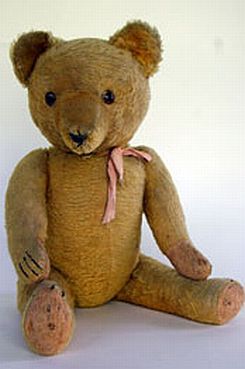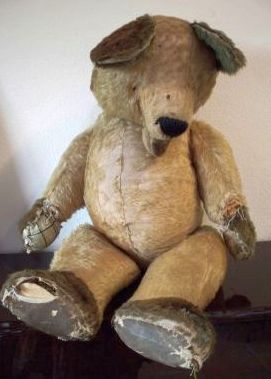|
|
Online, Monthly Teddy Bear Magazine |
| |
What's My Old Teddy Bear Worth?
|
Terry & Doris Michaud April 2009 |
| |
Some years ago I overheard a customer ask a similar question at an antique show, in regard to a rather large nondescript vase she was holding.
The dealer’s rather flippant answer was “It depends on whether I am buying or selling.” He then proceeded on a more friendly tone and pointed out that there were no markings on the vase to identify the maker or age, and it had some serious rim chips.
He finally came up with a price that he was willing to pay, and she was obviously disappointed, explaining that she saw a similar one on the Antiques Road Show that was appraised at substantially more than the amount the dealer was quoting.
When the road how expert quotes a value, it should be understood that it is for that specific item, not all “similar” items of the same category. You also must note that he may be quoting an auction value, a retail value or an insurance value. There could be a fairly wide spread from one category to the other.
Typically the auction quote will be the lower figure, the retail price will be somewhere in the middle, and the insurance price is generally the highest. There are many reasons the price will vary greatly, and we’ll discuss some of them. |

Photo courtesy www.Yesterprints.com
When purchasing an old teddy from the original owner, always ask if there are pictures of her with the bear. A photo can add 20 to 30% to the value
|
Trying to establish a fair secondary market value for an antique or collectible is not a simple task, regardless of whether you are buying or selling.
Our specialty has always been in the field of teddy bears, dolls and toys, but the information we offer can generally be applied to most any category.
One of the first myths we need to look at is age. Many people are convinced that age is the primary factor in determining value.
While it certainly can influence the price, it is not the biggest factor.
I have seen collectibles from the Baby Boomer age (1950s-1970s) command a substantially higher price than an early cast iron toy from the turn of the century. |
As always, it is a question of supply and demand. It’s true that the supply of early cast iron toys is limited, but one has to recognize that the number of people who played with these toys has been greatly diminished by age as well.
The limited number that remain may have already completed their collection or are no longer collecting. The Baby Boomer crowd are just coming of age where they have disposable income that allows them to invest in toys of their childhood.
With the extensive number of price guides on the market today that cover every antique and collectible imaginable, it should be a simple task to simply thumb through, find your precious collectible pictured exactly like yours, then see what that author has established as the current value.
Unfortunately, many people overlook the fine print in the price guide that tells you it is only the author’s best judgment on value, which may or may not be based on extensive research. Most often the author will further state that the price can vary dramatically, depending on condition, desirability, geographic location, and fluctuations in the marketplace.
Having written two price guides, I know just how difficult it is to come up with accurate information. At best, most price guides can simply give a range of values for a specific category, but be aware that that range can vary as much as several hundred percent!
It can be an educational exercise to check several price guides to determine a value for a specific item, then go to the Internet and see what the same or similar item is being offered for by specialty dealers. Finally, go to eBay and check to see what prices that item has been selling for recently. eBay is probably a much better indication of current market value than a price guide that was written months or even years ago. The market does change, and sometimes rapidly. |
A much larger influence on price that is often overlooked is condition. I recall many years ago getting a phone call from a customer who wanted to know what her doll was worth. I tried to explain that it was virtually impossible to quote a realistic value without examining the doll. She was not about to give up, and so we asked several questions. She did not know the age or the maker, but stated emphatically that it was in mint condition.
In fact, her response to just about every question we asked was “I don’t know about that, but it is in mint condition.”
I pursued the issue by asking about blemishes, signs of play wear, etc. and finally she said “well, it’s in mint condition except for one little thing - the face is missing.” When I asked for more details, it turns out that the face literally was missing. Their dog had taken a significant bite out of this doll!
I then suggested that the doll probably had great sentimental value, but without seeing it we simply could not suggest a fair price for her to sell it for.
|

Bing teddy bear. Photo from authors’ book “Buying & Selling Teddy Bears.” A 1920 Bing teddy that is considered scarce. Even without the trademark button, He can command a handsome price.
|
The top three factors in our experience to determine a fair market value are: condition, condition and condition!
In our last price guide we did an entire section on how condition can affect the value. Mint condition is generally accepted to be an item that has never been played with and is just like it came from the store originally. It may still be in the original box, which can add significantly to the value.
Good condition is an item that has had some use but shows no signs of wear. Fair condition will show some wear from play (slight worn spots on a mohair teddy, for example) minimal color fading, and perhaps some simple minor damage that can often be repaired by the purchaser. Poor condition is just that – a teddy bear that is nearly bald, pads torn open with stuffing coming out, missing eyes and/or ears, etc. |

Old worn teddy bear. Photo courtesy www.bearessentials.ie (Ireland). This well loved old timer still offers great charm, if not value.
|
In our last price guide we attempted to assign a value scale based on condition.
Starting at 100 points, we suggested adding 25 points for an item never played with (and I do mean never – right from the store). Add 50 points if it is in the original undamaged box.
Now we start deducting points. In the case of a teddy bear, you can loose 5 or 10 points each for missing eyes, nose, small holes in pads, minor mohair loss, soiling, color fading – and the list goes on. We take away 15 to 20 points if the bear has a musty smell, and a full 50 points if there are signs of dry rot (a condition generally caused by storage in excessive heat and/or moisture where the cotton fabric under the mohair literally comes apart).
Without going into a lot of detail, you should be able to recognize that the mint condition collectible could well be worth the price guide quote of $500.00, where the same item in poor condition could be a fraction of that value. |
A question we have heard hundreds of times is “should I have my teddy/toy/doll repaired, or will that hurt the value?”
I am sure you can get a variety of opinions on this subject, but our response is most often to tell the person that if the item has reached the stage where it needs repair, it has already lost value.
Good professional repair could very well restore some or most of that lost value, but it will never achieve the value it had in original condition. The yardstick we use to determine doing repair is, if the damage is “life threatening ” by all means get it repaired.
By that, we suggest that if the pads on a teddy bear have been completely torn or worn away and the stuffing is coming out, it’s time for repair! If it is a minor situation, we most often will leave it as-is.
An example is a delightful teddy bear we found that had lost his original eyes many years ago, and some kindly grandmother had replaced them with white buttons. The owner of the bear said she could never remember a time in her childhood when the bear had something other than those buttons. We felt it was part of his character, and they remain with him to this day.
If you do indeed opt to have some professional repair done (and we highly recommend having most repairs done by someone with experience rather than attempting it yourself), we recommend two things; get an estimate on what the cost will be, and ask how long the work might take. It is also worth asking for references from past customers.
Some thoughts on buying.
We all live for the day we can find that “sleeper” at a yard sale, and yes, it does happen. Unfortunately it is generally a once-in-a-lifetime experience, so it would be a mistake to assume that every yard sale has a treasure waiting for you.
We do hit them on occasion, as well as estate sales and auctions. It is also well worth letting everyone you come in contact with that you are a collector of teddy bears/toys/dolls. I can guarantee your heart will pick up the beat when you get a response from a neighbor that says “Gee, I didn’t know that. My late wife left me with a basement full of them. I am planning to remarry and I need to get rid of that junk!”
This may fall into the category of a rare event, but it does happen. If you are prone to scan the goodies offered on eBay, be aware that there are words that should be forever banned such as: “Mint condition – vintage - rare “ and a number of other descriptive phrases that are badly misused.
Too often the picture shown is of such poor quality that it is nearly impossible to tell what the item really looks like. Sometimes the seller will photograph the best side and “forget” to mention the damage on the other side. That is not to say that you cannot find a good buy on eBay, but proceed with great caution. It is probably the number one outlet for reproductions, fakes and fantasy pieces.
We have been collectors and dealers of juvenilia for over 50 years, and I can say that the best values that have come our way have been from fellow collectors who share our love.
Attend the next show that features your favorite collectible. Better yet, sign up for a table to sell off what you no longer want. It not only gets you in the door ahead of those hungry buyers, but gives you the opportunity to check out the goodies as they are being unpacked.
There is no better reward in this hobby than sharing your enthusiasm with a fellow collector.

Terry & Doris Michaud
Carrousel
Members since March 2009
|

Home • Contact Us • Classified Ads • Join Bears&Buds
|
| |
|
|
|
|
|


 3428 Hillvale Road
3428 Hillvale Road  Louisville, KY 40241 USA
Louisville, KY 40241 USA